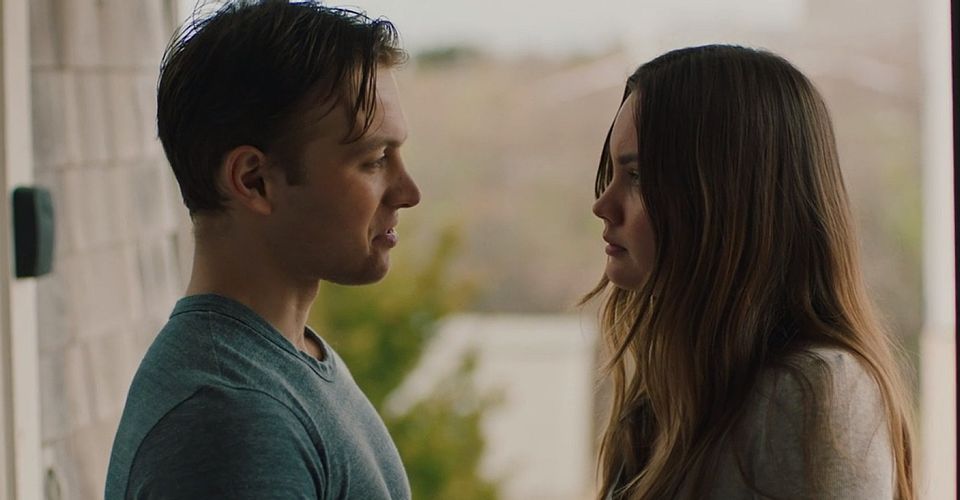The Beach House Ending & Infection Explained

Warning! Spoilers for The Beach House ahead.
Jeffrey A. Brown made his directorial debut with the 2019 body eco-horror film The Beach House, which is available to stream through Shudder as of July 2020. The Beach House takes an eerie look into the future of the ecosystems that people navigate on a daily basis if they are not cared for. Starring Liana Liberato as Emily and Noah Le Gros as her boyfriend Randall, the two experience what could happen if temperatures continue to rise and dormant microbes awaken to erase humanity. With such a complex premise, the film ends with more questions than answers.
When the couple first arrives at Randall’s family beach house, they quickly discover that they are not alone despite the apparent vacancy of the general neighborhood. Longtime friends of the family, Jane (Maryann Nagel) and Mitch (Jake Weber) also appear to be inhabiting the vacation home at the same time. After a night of exuberance, a strange fog rolls in, causing an even more bizarre environmental and physical impact on the group and the small beach side town. It shares remarkable similarities with the M. Night Shyamalan film The Happening (2008) where nature takes the Earth back from humanity by force. As each of the characters become infected, it becomes clear that the threat they are facing is within the ocean.
The Beach House also features a common motif to horror films like John Carpenter’s 1980 film, The Fog, when spirits return from the sea to enact their revenge while a fog envelops the town. Frank Darabont’s 2007 adaptation of Stephen King’s novella The Mist features a similar threat hidden within the mysterious environmental phenomenon. The Beach House is a thought-provoking film that features famous motifs surrounding the fear of the unknown and the threat that, one day, the environment could seek its revenge.
How Mitch, Jane, And Randall Became Infected

Early on in the film, the environment immediately shifts from a sunny day to a murky sky with trees covered in inexplicable spores. The following morning, everyone except for Emily appears to be experiencing the effects of what this newly toxic landscape is capable of. Yet, there’s no concrete answer on how each character became infected. Each infection grows and appears differently based on what happened and where people were that night. When Jane goes missing out in the fog, she is seen touching spores on the trees that are then transferred onto her skin; this is when she gets infected. Mitch goes out looking for her and inhales the toxic air.
The most covert transmission of the infection occurs when Randall ingests an oyster at dinner. The mollusk takes over his entire gastrointestinal tract, leading to his demise. Jane dies due to the skin lesions attained by the spores, Mitch is swept off to sea after being hypnotized by the air, and Randall throws up the parasitic oyster, which transforms into a mutated humanoid. Each character’s infection took over them in varying degrees based on the time of contact, how it was contracted, and where it’s located. In fact, Emily’s infection takes the entirety of the film because she is the only one who successfully removes the initial parasite. Regardless, she ultimately dies.
The Jellyfish On The Beach Explained

During the dinner that sparks everyone’s infection, Emily expresses to the group that she dreams of becoming an astrobiologist, which involves the study of the feasibility for sustainable life on planets based on environmental factors. Her undergraduate training is in organic chemistry, which she utilizes throughout the film to try to explain what is happening. At first, she proposes that it is a toxic algae bloom, but emergency radio reveals that it is actually caused by dormant microbes that have surfaced due to rising ocean temperatures. This environmental factor brought aquatic life that could no longer inhabit the depths of the sea to the surface, including the jellyfish.
These jellyfish carry a parasite of their own. After stepping on one, a foot-long worm burrows into Emily’s foot, which she later removes. Hundreds of years ago, jellyfish were parasitic and carried such a worm that could infect predators as well as other fish. Once they leave their initial host, they coil and straighten within a new one which, in the case of The Beach House, is Emily. Therefore, not only did the microbes surface to threaten humanity, but pre-evolution sea creatures resurfaced to assist in the battle. The jellyfish are a direct link to the theory that ancient aquatic life still lies at the bottom of the darkest depths of the ocean and will resurface as the climate continues to change.
What Happened To Emily In The Beach House

As the film comes to an end, Emily desperately attempts to flee from the beach house and escape the toxic air that surrounds her. Ultimately, she cannot escape from the environmental nightmare. In an unexpected and shocking end, Emily lays on the beach close to the water. She reassures herself that everything will be okay in an attempt to accept her death. As the waves wash over her body, she disappears. It’s as if she completely dissolves into the water, which she technically does, based on how her specific infection impacts her physically.
The way that Emily dies is typical to how jellyfish nearly evaporate when they are washed up on the beach. Due to the fact that each of the other three characters’ deaths reflect the way they were infected, it’s an obvious choice to have her die in the same way as what infected her. Considering Randall began to transform into a mollusk and birthed a humanoid oyster, it is likely that the worm that embedded itself into Emily began to transform her genetic makeup to that of a jellyfish. Just as they were washed up on the shore, as is Emily. Since jellyfish are composed almost entirely of water, they begin to evaporate once they are on land. The wave that hits Emily completely disintegrates her because she was already beginning to evaporate.
The Beach House is an impressive directorial debut from Jeffrey A. Brown. He artfully crafts complex characters and an infection that showcases his extraordinary attention to detail. With the rise of eco-horror, The Beach House stands out among the crowd for its thought-provoking capabilities and direct message about the current state of the world.
About The Author

















